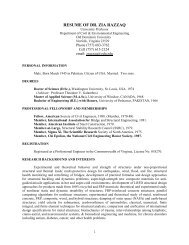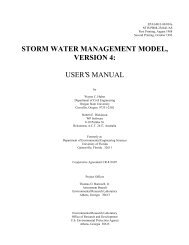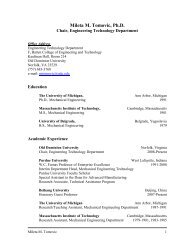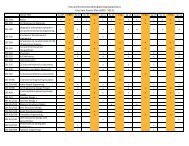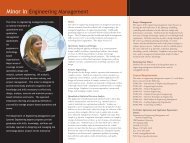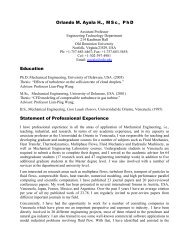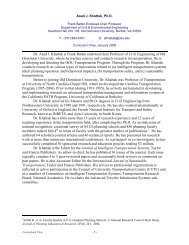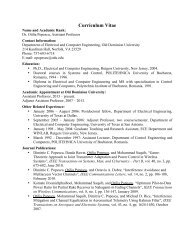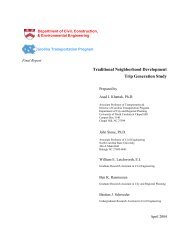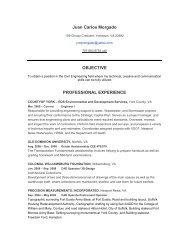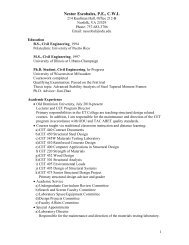Queue length estimation from probe vehicle ... - ResearchGate
Queue length estimation from probe vehicle ... - ResearchGate
Queue length estimation from probe vehicle ... - ResearchGate
Create successful ePaper yourself
Turn your PDF publications into a flip-book with our unique Google optimized e-Paper software.
ARTICLE IN PRESS4 G. Comert, M. Cetin / European Journal of Operational Research xxx (2008) xxx–xxxPðL p ¼ l p Þ¼ XlpX 1PðL p ¼ l p jN ¼ n; N p ¼ n p ÞPðN p ¼ n p jNn p¼0 n¼l p¼ nÞPðN ¼ nÞ:Then, the marginal distribution of L p becomesPðL p ¼ l p Þ¼ Xlpn p¼1ð13ÞX 1 l p 1p np ð1 pÞ n np PðN ¼ nÞ; for l p P 1;n¼l pn p 1PðL p ¼ 0Þ ¼ X1ð1 pÞ n PðN ¼ nÞ; for l p ¼ 0:n¼0ð14ÞThe formulation presented so far can be utilized to assess the relationshipbetween the percentage of <strong>probe</strong>s p and the accuracy of theestimated queue <strong>length</strong>s. The main input required is a probabilityfunction for the total number of <strong>vehicle</strong>s in the queue, P(N = n).The next two sections provide two examples to illustrate the applicationof this formulation.4. Analysis of arrivals on red (without overflow queue)At signalized intersections, if the overflow queue is ignored andthe number of arrivals per unit time is assumed to be Poisson withparameter k then, N is also a Poisson with parameter kR, where R isthe duration of the red interval. It should be noted that at isolatedintersections the use of Poisson distribution is common fordescribing the arrival process (Rouphail et al., 2001). Without lossof generality it is assumed that R = 1, then the probability functionfor N can be written asPðN ¼ nÞ ¼ e k k n; k > 0; n ¼ 0; 1; 2 ... ð15Þn!For illustration purposes an example is constructed where k is set to10. From Eq. (8), the expected queue <strong>length</strong> for this example can beobtained as follows:the percentage of <strong>probe</strong>s, and q is the parameter of the geometricdistribution.As it can be observed <strong>from</strong> Fig. 2, at smaller p and l p values (lessthan 10 or so) the expected value is close to k, as the most informationon-hand is based on the arrival rate. On the other hand, whenp is large then the expected value tends to the location of the last<strong>probe</strong>. Obviously, at the extreme when p = 1.0, the location of thelast <strong>probe</strong> is the same as the queue <strong>length</strong>.Fig. 3 shows the variance of the conditional queue <strong>length</strong> versusthe location of last <strong>probe</strong> for different p values. The results are inagreement with the intuition that variance decreases with higherp values. Variance is larger when l p is small; and as l p becomes largervariance tends to zero even for small p values. This implies thatqueue <strong>length</strong> can be estimated with more accuracy when l p islarge.The previous two figures illustrate how expected queue <strong>length</strong>and its variance change by the location of last <strong>probe</strong> in the queuebut they do not provide any information about the likelihood ofoccurrence of each l p value. This information is needed to assessthe overall or weighted accuracy at a given p value. Fig. 4 showsthe probability mass function of L p for different p values calculated<strong>from</strong> Eq. (14). Asp value increases the bell-shaped distribution becomesmore symmetrical around k = 1 and the probability of l pbeing zero (or the probability of having no <strong>probe</strong> = exp( kp)) getscloser to zero.Using the probability mass functions in Fig. 4, one can calculatethe weighted variance (see Eq. (12)) at a given p value to determinethe overall expected deviations of the estimates <strong>from</strong> the truequeue <strong>length</strong>s. Weighted variances are calculated at various p levelsand plotted in Fig. 5. As anticipated, the variance reduces as pincreases and becomes zero as p approaches to 1. This figure certainlyprovides valuable information needed in trading off the levelEðNjL p ¼ l p Þ¼ X1n¼l pn½ð1 pÞkŠnn! P 1k¼l p½ð1pÞkŠ kk!; for l p P 1: ð16ÞFig. 2 shows the relationship between the expected queue <strong>length</strong>versus the location of the last <strong>probe</strong> l p for five different <strong>probe</strong> <strong>vehicle</strong>proportions p. It can be observed that, for all p values, the expectedqueue <strong>length</strong> converges to the location of last <strong>probe</strong> as l pincreases. Therefore, one can write lim lp!1ðEðNjL p ¼ l p Þ L p Þ¼0.This limit is numerically verified for Poisson distribution P(N = n).However, it should be noted that this result depends on the probabilitydistribution of N. For example, if P(N = n) is geometric, thenlim lp!1ðEðNjL p ¼ l p Þ L p Þ¼a=ð1 aÞ, where a =(1 p)(1 q), p isFig. 3. Variance of the conditional queue <strong>length</strong> versus L p .Fig. 2. Expected value of queue <strong>length</strong> given the location of the last <strong>probe</strong> <strong>vehicle</strong> inthe queue.Fig. 4. Marginal probability mass function (pmf) of L p .Please cite this article in press as: Comert, G., Cetin, M., <strong>Queue</strong> <strong>length</strong> <strong>estimation</strong> <strong>from</strong> <strong>probe</strong> <strong>vehicle</strong> location and the impacts of samplesize, European Journal of Operational Research (2008), doi:10.1016/j.ejor.2008.06.024



